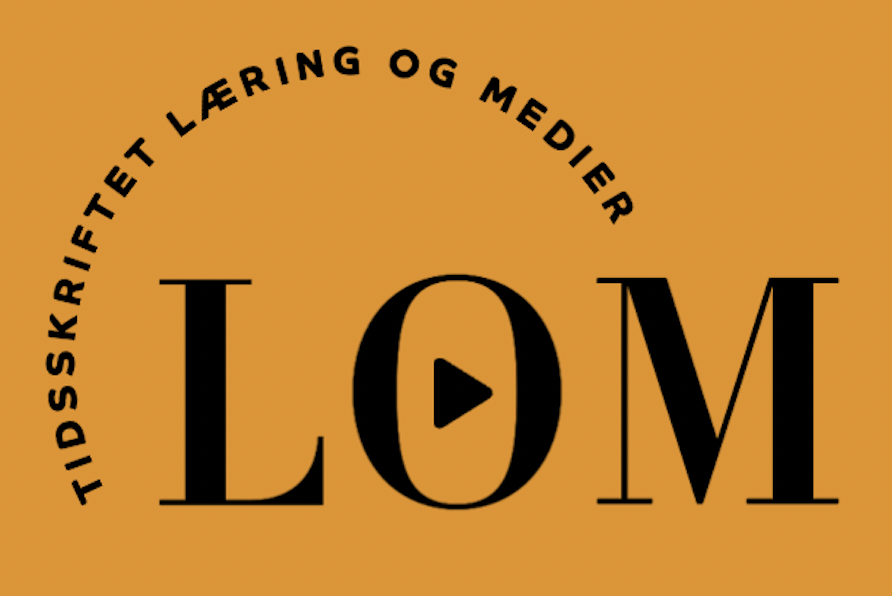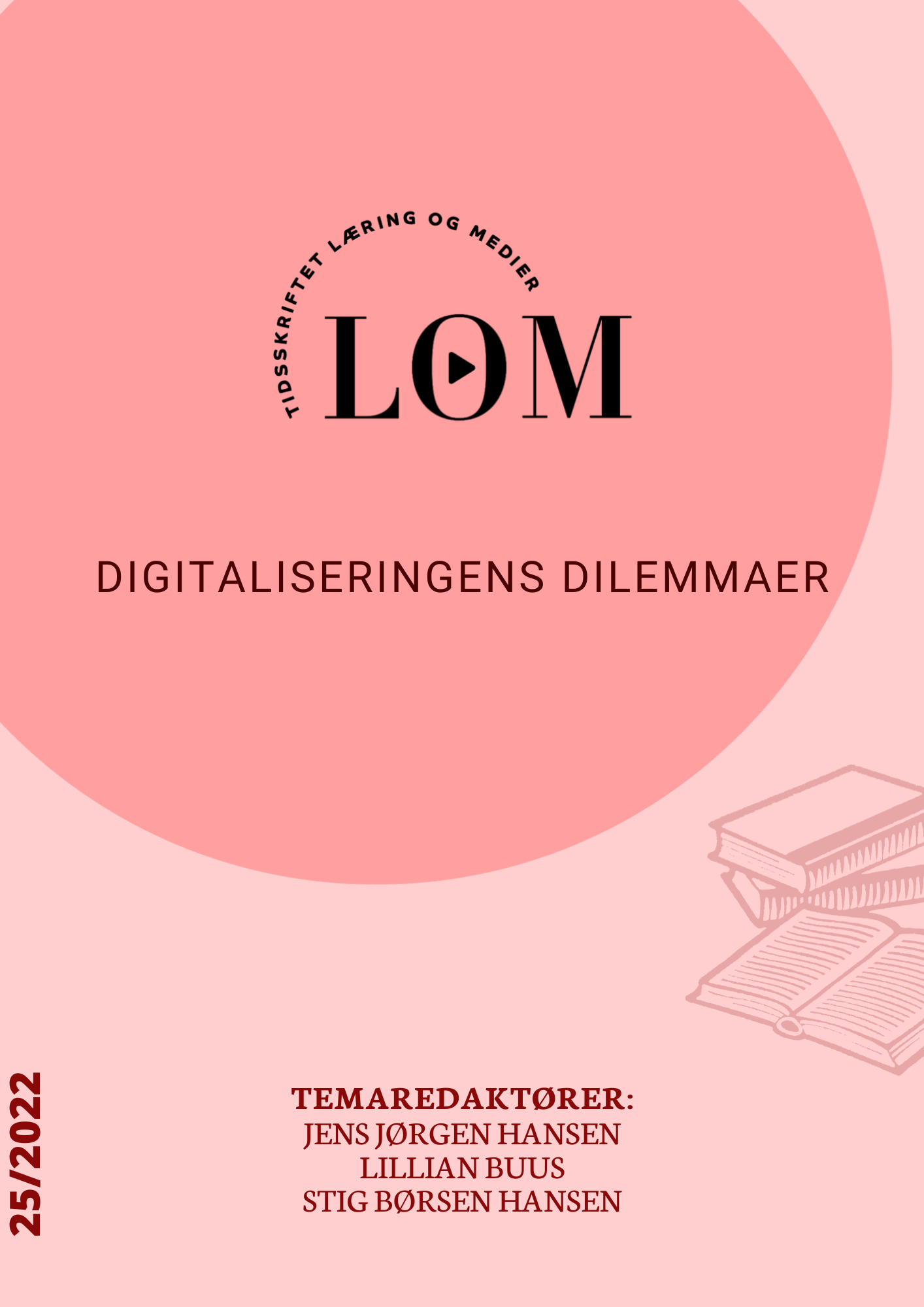Dilemmaer i translation og transformation af erfaringsbaserede kollaborative læringsformer til digitale læringsplatforme
DOI:
https://doi.org/10.7146/lom.v15i25.128542Keywords:
envisioning scenarios, AI, machine learning, learning design, ECL, Automated feedback, digital learning, ecotones, ecosystemsAbstract
Experience-based collaborative learning (ECL) as expressed in problem-based learning, case-based learning and hacker pedagogy contributes to the development of competencies central to the advancement of practice and profession. In recent years, and especially during Covid19, a large part of teaching activities in higher and continuing education have been partly or completely converted to digital, hybrid or blended formats. However, there is a lack of knowledge about how these conversions have affected the predominantly experience-based and collaborative educational programs and what dilemmas may arise while attempting to translate and transform this type of learning to digital educational programs on learning platforms. The aim of this paper is therefore to investigate what characterizes ECL educational programs and what dilemmas arise when they are converted to digital learning formats, based on experiences attained through the research and development project ‘Unified platform For Learning and Development’ (UnFoLD). Based on an analysis of the ecosystems of the project, three central dilemmas about designing learning processes, not only systems, envisioning as a method of understanding and working with the hierarchies of the system and automated qualitative feedback will be highlighted. Additionally, we propose a method of mitigating these dilemmas through envisioning and a focused design process.
Downloads
References
Andersen, M. H., Gerwien, R. G., & Kammer, A. (2020). Sammen, hver for sig: Universitetsstuderendes læringsstrategier under COVID19-nedlukningen. Tidsskriftet Læring og Medier (LOM), 13(23), 18–18. https://doi.org/10.7146/lom.v13i23.122032
Cavalcanti, A. P., Barbosa, A., Carvalho, R., Freitas, F., Tsai, Y.-S., Gašević, D., & Mello, R. F. (2021). Automatic feedback in online learning environments: A systematic literature review. Computers and Education: Artificial Intelligence, 2, 100027. https://doi.org/10.1016/j.caeai.2021.100027
Colchester, K., Hagras, H., Alghazzawi, D., & Aldabbagh, G. (2016). A Survey of Artificial Intelligence Techniques Employed for Adaptive Educational Systems within E-Learning Platforms. Journal of Artificial Intelligence and Soft Computing Research, 7(1), 47–64. https://doi.org/10.1515/jaiscr-2017-0004
Dau, S. (2015). Studerendes orientering i fleksible professionsuddannelsers læringsrum: Et narrativt casestudie af vidensudviklingens veje og afveje [Aalborg Universitetsforlag]. https://doi.org/10.5278/vbn.phd.hum.00007
Dau, S., & Ryberg, T. (2014). Disruptions and Disturbance as Challenges in a Blended Learning (BL) Environment and the Role of Embodied Habit Orientation: The 13th European Conference on e‐Learning. Proceedings of the 13th European Conference on E‐Learning - ECEL‐2014, 156–162.
Faurholt, L., & Kofod-Jensen, L. (2010). Next generation—Nationalt e-læringssystem byggende på Open Souce (Nye Institutioner/DEFF. Hentet d. 08.07.2021 fra Next Generation (deff.dk), p. 25). https://www.deff.dk/uploads/media/Next_Generation_-_afrapportering.pdf
Fawns, T., Mulherin, T., Hounsell, D., & Aitken, G. (2021). Seamful learning and professional education. Studies in Continuing Education, 0(0), 1–17. https://doi.org/10.1080/0158037X.2021.1920383
Ferguson, R. (2012). Learning analytics: Drivers, developments and challenges. International Journal of Technology Enhanced Learning, 4(5/6), 304–317.
Goodyear, P. (2005). Educational design and networked learning: Patterns, pattern languages and design practice. Australasian Journal of Educational Technology, 21(1), Article 1. https://doi.org/10.14742/ajet.1344
Guzmán-Valenzuela, C., Gómez-González, C., Rojas-Murphy Tagle, A., & Lorca-Vyhmeister, A. (2021). Learning analytics in higher education: A preponderance of analytics but very little learning? International Journal of Educational Technology in Higher Education, 18(1), 23. https://doi.org/10.1186/s41239-021-00258-x
Jensen, C. G. (2020). Playing with Sequential Learning and and Inquiry Processes by Bringing “World of Warcraft“ to the Real World: Based on Reflective Practice-based Learning [Aalborg Universitetsforlag]. https://www.ucviden.dk/da/publications/playing-with-sequential-learning-and-and-inquiry-processes-by-bri
Kilińska, D., & Ryberg, T. (2019). Connecting Learning Analytics and Problem-Based Learning – Potentials and Challenges. Journal of Problem Based Learning in Higher Education, 7(1), Article 1. https://doi.org/10.5278/ojs.jpblhe.v7i1.2545
Laursen, R. (2020). Does the Combination of Professional Leadership and Learning Management Systems Signal the End of Democratic Schooling? Research in Educational Administration & Leadership, 5(2), 342–374.
Mangaroska, K., & Giannakos, M. (2019). Learning Analytics for Learning Design: A Systematic Literature Review of Analytics-Driven Design to Enhance Learning. IEEE Transactions on Learning Technologies, 12(4), 516–534. https://doi.org/10.1109/TLT.2018.2868673
Popenici, S. A. D., & Kerr, S. (2017a). Exploring the impact of artificial intelligence on teaching and learning in higher education. Research and Practice in Technology Enhanced Learning, 12(1), 22. https://doi.org/10.1186/s41039-017-0062-8
Popenici, S. A. D., & Kerr, S. (2017b). Exploring the impact of artificial intelligence on teaching and learning in higher education. Research and Practice in Technology Enhanced Learning, 12(1), 22. https://doi.org/10.1186/s41039-017-0062-8
Selwyn, N. (2016). Is Technology Good for Education? John Wiley & Sons.
Sørensen, M. T., & Pedersen, J. M. (2018). Students’ experience with Dassault Systemes’ ILICE platform for PBL. 7th International Research Symposium on PBL, 75–84.
Tahiru, F. (2021). AI in Education: A Systematic Literature Review. Journal of Cases on Information Technology (JCIT), 23(1), 1–20. https://doi.org/10.4018/JCIT.2021010101
van der Maarel, E. (1990). Ecotones and Ecoclines Are Different. Journal of Vegetation Science, 1(1), 135–138. https://doi.org/10.2307/3236065
Viberg, O., Hatakka, M., Bälter, O., & Mavroudi, A. (2018). The current landscape of learning analytics in higher education. Computers in Human Behavior, 89, 98–110. https://doi.org/10.1016/j.chb.2018.07.027
Wistoft, K., Christensen, J. H., & Qvotrup, L. (2020). Elevernes trivsel og mentale sundhed: Hvad har vi lært af nødundervisningen under coronakrisen? Learning Tech – Tidsskrift for læremidler, didaktik og teknologi, 7, 40–65. https://doi.org/10.7146/lt.v5i7.120865
Zawacki-Richter, O., Marín, V. I., Bond, M., & Gouverneur, F. (2019). Systematic review of research on artificial intelligence applications in higher education – where are the educators? International Journal of Educational Technology in Higher Education, 16(1), 39. https://doi.org/10.1186/s41239-019-0171-0
Downloads
Published
How to Cite
Issue
Section
License
Copyright (c) 2022 Camilla Gyldendahl Jensen, Susanne Dau, Nicolaj Riise Clausen, Thomas Ryberg, Lykke Brogaard Bertel

This work is licensed under a Creative Commons Attribution-NonCommercial-NoDerivatives 4.0 International License.

Articles published in the Journal of Learning and Media are licensed under a Creative Commons Attribution-NonCommercial-NoDerivatives 3.0 Unported Licens.
Authors retain copyright and grant the journal right of first publication; simultaneously articles are licensend under the Creative Commons Attribution license: Attribution-NonCommercial-NoDerviatives (by-nc-nd). Read about this license at https://creativecommons.org/licenses/by-nc-nd/3.0/
---
At LOM.dk, you will also find articles from the discontinued Journal for the Continuing and Further Education of the Danish Universities (UNEV). Note that special rules apply to UNEV articles:
It is the authors and any other copyright holder who have the copyright of articles published under the auspices of UNEV, and access to the articles is contingent on users acknowledging and complying with the associated legal guidelines:
- Users may download and print one copy of any UNEV publication for private studies or research.
- The redistribution of articles or the use of these for revenue-funded activities or commercial purposes are not allowed.
- It is not allowed to distribute the URLs of UNEV articles.


